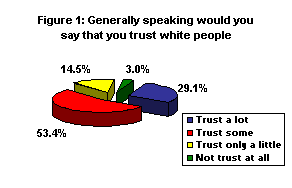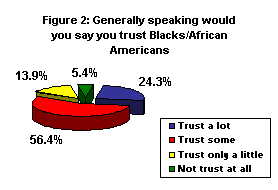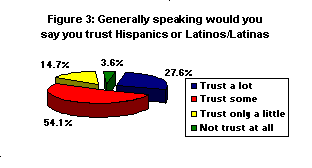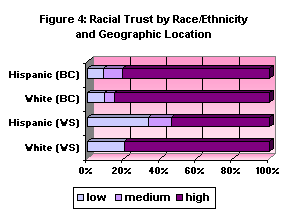Measures of San Antonio’s Social Capital—Perceptions of Trust for Different Race and Ethnic Groups
By Darla Norton, Research Associate, Richard J. Harris, Professor, Juanita M. Firestone, Professor, and Arturo Vega, Ph.D., Associate Professor
Issue:
This issue brief is the fifth of a series of analyses that examine social capital in Bexar County. (San Antonio,) Texas and focuses on racial and ethnic trust at the community level. Social capital is a measure of the levels of social relationships and social networking within communities and individuals and is typically measured by levels of definition of social trust, networks and reciprocity that connect communities and form social cohesion. Here, we expect that inter-racial/ethnic trust is an important element of social cohesion and social capital. High levels of inter-racial/ethnic trust are expected to be associated with high levels of social capital within a community. The complement is also true—low levels of inter-racial/ethnic trust are related to low levels of community social capital.
Our research questions are: What are the levels of racial/ethnic trust in San Antonio, Texas? And, are there significant variations in levels of racial/ethnic trust among key demographic groups that make up the community?
Data and Methods:
Data for this study were collected during the San Antonio Survey 2003 (SAS 2003), which was conducted during the weeks of October 12-28th, 2003.[i] Responses are from a random probability sample of the general population of adults 18 years of age and older in Bexar County, (San Antonio) Texas, with listed phone numbers. A split sample design produced 423 responses from a random sample of individuals within the county, and an additional oversample of 136 respondents living on San Antonio’s West Side for a total of 559 respondents.[ii]
To measure levels of racial/ethnic trust, a racial/ethnic trust index was created using the mean (average) level of trust across two of the following three groups, excluding the respondents’ own racial/ethnic group. Higher values on the index equal higher racial/ethnic trust.
- TRUST WHITES: Would you say you trust white people (1 = “not at all,” 2 = “a little,” 3 = “some,” 4 = “a lot”)?
- TRUST AFRICAN AMERICANS: Would you say you trust black people (1 = “not at all,” 2 = “a little,” 3 = “some,” 4 = “a lot”)?
- TRUST HISPANICS: Would you say you trust Hispanic people (1 = “not at all,” 2= “a little,” 3 = “some,” 4 = “a lot”)?
Findings: Figures 1 thru 3 present different measures of racial/ethnic trust. When non-white respondents were asked if they would trust white people, nearly three in ten (29.1%) of respondents replied that they trust white people “a lot,” while just over half (53.4%) reported that they trust white people “some,” and fewer than twenty percent of respondents do not trust white people “at all” (14.5%) or trust white people only “a little” (3.0%; see Figure 1).
Figure 2 presents how much non-African American respondents trust African Americans. The largest percentage of respondents trust African Americans “some” (56.4%), while nearly a quarter of the respondents (24.3%) trust them “a lot”, and fewer>than twenty percent of the respondents do not trust African Americans “at all” (13.9%) or only “a little” (5.4%).
Figure 3 presents how much non-Hispanic respondents trust Hispanics. Well over half of the respondents trust Hispanics “some” (54.1%), while over one-fourth of the respondents (27.6%) trust Hispanics “a lot”. Fewer than twenty percent of respondents do not trust Hispanics “at all” (14.7%) or only “a little” (3.6%). We observe from Figures 1 thru 3 that there is no significant difference in racial/ethnic trust between the whites, African Americans and Hispanics.
 |
 |
 |
Table 1 presents distributions of the racial/ethnic trust index by demographic determinants. Responses were statistically significant and moderately related to income, race/ethnicity and educational attainment, while the relationship was substantial for West side. Levels of racial/ethnic trust increase as income levels increase with only six in ten respondents in the lowest income group reporting high levels of racial/ethnic trust compared to the eight in ten respondents in the higher income groups. Anglo respondents had the highest levels of racial/ethnic trust with eighty five percent of respondents reporting that they had high levels of racial/ethnic trust compared to sixty eight percent (67.9%) for Hispanics and almost seventy percent (69.7%) for African Americans. Less than half (47.5%) of the respondents with less than a high school education report high levels of racial/ethnic trust compared to over eight in ten (84.2%) respondents with a bachelor’s degree and the nine in ten (93.9%) with graduate degrees. Finally, living on the West side had the strongest relationship with racial/ethnic trust with just over half of respondents on the West side reporting high levels of racial/ethnic trust compared to the over eight in ten respondents in the rest of Bexar County.
Table 1: Racial/ethnic Trust by Demographic Determinantss
| LOW | MEDIUM | HIGH | Chi.Sq. | Sig | Cramers V | Gamma | |
| AGE | |||||||
| 18-29 | 23.0% | 6.9% | 70.1% | 13.31 | n/s | 0.13 | 0.04 |
| 30-39 | 10.4% | 7.5% | 82.1% | ||||
| 40-49 | 23.1% | 7.7% | 69.2% | ||||
| 50-64 | 14.5% | 6.4% | 79.1% | ||||
| 65+ | 12.8% | 15.1% | 72.1% | ||||
| INCOME | |||||||
| $0-29,999k | 27.3% | 12.5% | 60.2% | 17.18 | 0.01 | 0.16 | 0.36 |
| $30-59,999k | 12.0% | 9.4% | 78.6% | ||||
| $60,000k + | 12.4% | 5.6% | 82.0% | ||||
| LOOP | |||||||
| Inside | 15.2% | 8.9% | 75.9% | 0.55 | n/s | 0.04 | -0.08 |
| Outside | 17.7% | 9.4% | 72.8% | ||||
| RACETH | |||||||
| White | 9.6% | 5.4% | 85.0% | 15.72 | 0.01 | 0.13 | -0.35 |
| Hispanic | 20.7% | 11.4% | 67.9% | ||||
| Afri Am. | 21.2% | 9.1% | 69.7% | ||||
| DEGREE | |||||||
| <HS | 36.1% | 16.4% | 47.5% | 38.81 | 0.01 | 0.21 | 0.39 |
| High School | 16.0% | 8.6% | 75.3% | ||||
| Some Coll | 16.3% | 10.5% | 73.3% | ||||
| Bachelors | 7.9% | 7.9% | 84.2% | ||||
| Graduate | 6.1% | 0.0% | 93.9% | ||||
| GENDER | |||||||
| Male | 19.4% | 6.9% | 73.6% | 4.24 | n/s | 0.10 | 0.08 |
| Female | 13.5% | 10.8% | 75.7% | ||||
| WESTSIDE | |||||||
| Westside | 33.9% | 11.0% | 55.1% | 43.07 | 0.01 | 0.31 | -0.58 |
| Bexar | 9.3% | 8.0% | 82.6% |
We have previously seen in the bivariate analyses that respondents living on the West side are less trusting of other racial/ethnic and ethnic groups compared to respondents in the rest of Bexar County. This difference between the West side and the rest of Bexar County may be due to the large proportion of Hispanics living on the West side. Figure 4 shows that when we examine racial/ethnic trust by race/ethnicity controlling for geographic location we observe a similar pattern to the bivariate analysis with only half of Hispanics on the West side reporting high levels of racial/ethnic trust compared to the eighty percent in the rest of Bexar County (54.1% vs. 80.8%). There was very little variation between Anglos.
 |
Discussion:
As demonstrated in issue brief #1 (social trust) communities that are characterized by racial, ethnic, religious, or political diversity typically demonstrate lower levels of trust. This is likely due to the fact that individuals are more trusting of others similar to themselves. These survey findings suggest that levels of racial/ethnic trust in San Antonio are significantly related to income, race/ethnicity, educational attainment and living on the West side. Residents living on the West side, racial/ethnic and ethnic minorities, the poor, and the least educated exhibit the least amount of racial/ethnic trust. In a racially and ethnically diverse community such as San Antonio, trust of other racial and ethnic groups is crucial to building social networks and laying the foundation for civic engagement in the community—two essentials elements of social capital.
Notes
[i] The SAS 2003 is an annual survey conducted by UTSA students in research methods courses in sociology, criminal justice, kinesiology and public administration, in conjunction with The Culture and Policy Institute. The survey provides students with experience in survey research and an opportunity to measure the attitudes and perceptions of San Antonians on topics of the day. Juanita Firestone, Professor, Department of Sociology, is the principal investigator; Richard Harris, Professor, Department of Sociology, and Arturo Vega, Associate Professor, Department of Public Administration, are co-principal investigators.
[ii] The standard error for the entire sample, including the additional sample from the Westside, is +/- 4.1% with a confidence level of 95%. The SAS 2003 incorporated several questions from the Saguaro Seminar’s “Social Capital Community Benchmark Survey Short Form 2001.” The authors acknowledge the Seminar for its generosity in sharing the short form on line. www.ksg.harvard.edu/saguaro/pdfs/socialcapitalshortform.pdf